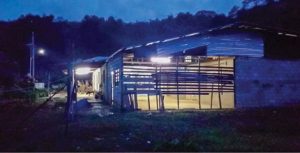The Sarawak Government, through the Ministry of Utilities Sarawak and its implementing agency Sarawak Energy is accelerating the delivery of rural electrification projects to ensure the provision of reliable and affordable electricity supply for the whole of Sarawak by 2025.
Since 2009, about 150,000 rural households in Sarawak have been lighted under various rural electrification strategies. This includes an extension of the grid system for rural areas with road accessibility under Rural Electrification Scheme or RES. It establishes localised micro-grids under a hybrid system for larger communities distant from the primary grid and smaller standalone micro-hydro or solar power systems for the most remote areas through the SARES or Sarawak Alternative Rural Electrification Scheme.
There were several challenges such as logistics due to area remoteness, wayleave issues, acceptance from villagers and the current global Covid-19 pandemic. However, Minister for Utilities Sarawak Dato Sri Dr Stephen Rundi Utom assured the public his ministry, working closely with Sarawak Energy, remained committed to ensuring that rural Sarawak would have access to 24-hour reliable and affordable electricity.
“We have an effective strategy and an efficient delivery mechanism to extend existing Sarawak’s grid into the interior, and for Sarawak’s most remote communities, we have the standalone off-grid solutions,” Rundi said.
“Through RES, we are extending grid lines into the interior by constructing electrical distribution poles and supply lines. Rural Power Supply Scheme or RPSS will supplement RES by introducing new transmission, distribution lines and substations at strategic rural locations to enable RES to be extended to the more remote areas.”
Under RPSS, power supply reliability will be reinforced with substations that can quickly isolate faulty equipment to restore supply speedily.
“The simultaneous implementation of these rural electrification strategies is expediting the electrification plan of the Sarawak government. This is evident when Sarawak’s rural electricity coverage grew from just 56 per cent in 2009 to 95 per cent in 2020,” he added.
Better standard of living
In 2020, with the electrification of 6,600 households, Sarawak’s rural electricity coverage had reached 95 per cent and was expected to achieve 97 per cent in the coming months.
For the Sri Aman division overall, rural electrification coverage now stood at 94.7 per cent. Just over 780 rural households left to be lighted up for the area to reach total electrification.

By the end of 2021, 16 villages in the Lubok Antu district of Sri Aman will be grid-connected. This will benefit about 1,040 residents from 208 rural households in Lemanak and Engkari with a 24-hour reliable electricity supply.
Under Phase 1 of RES for the area, 114 rural households from nine villages in Lemanak are expected to receive grid connection by May 2021, with 12 households from two villages already electrified in December 2020.
RES Phase 2 will light up 359 rural households from 18 villages in Engkari and the remaining households of Lemanak by 2021/2022.
Although electrification works continue under full compliance with the relevant Standard Operating Procedures and stringent in-house Covid-19 precautionary measures, the pandemic has presented uncertainties and challenges to safe and timely work progression.
Lemanak is located about one to two-hour drive away from the Lubok Antu town and is reachable by uneven gravel roads and old logging tracks. It can take up to four hours to reach the last longhouse of Ulu Lemanak, a tributary of the Batang Lupar.
At Engkari, the closest longhouse is located around one hour away by boat from the Batang Ai jetty or accessible from the Lubok Antu town through a 1 to 2-hours drive on logging tracks.
The local communities mostly engage in small-scale fishing businesses. However, due to the distance from markets and without electricity, fresh catch cannot be kept long and must be sold immediately.
With a steady electricity supply, their catch can now be refrigerated and sold at markets in bigger and further away towns.

Rundi said: “With access to reliable electricity supply, our rural communities will enjoy greater convenience and opportunities for a better standard of living. For the fishing community at Engkari, they can have refrigerators to store their fresh catch longer.”
Sarawak Energy’s Vice President for Rural Electrification, Dr Chen Shiun said a dedicated team prioritised accelerating rural electrification implementation through the various initiatives.
“We are constructing the 33kV Nanga Kesit substation while extending our lines to reach communities at the last miles of Engkari and to supply a vast expanse of Lemanak.
“The substation is expected to be commissioned by the end of March 2021, and it will also enhance supply reliability to the entire Lubok Antu district,” Dr Chen added.
A new distribution system technology known as the Medium Voltage Covered Conductor (MVCC) has been adopted in considering the area’s harsh geographical conditions.
MVCC can withstand momentary contact with crops or vegetation without causing interruptions, which will help strengthen supply reliability.
— @green









